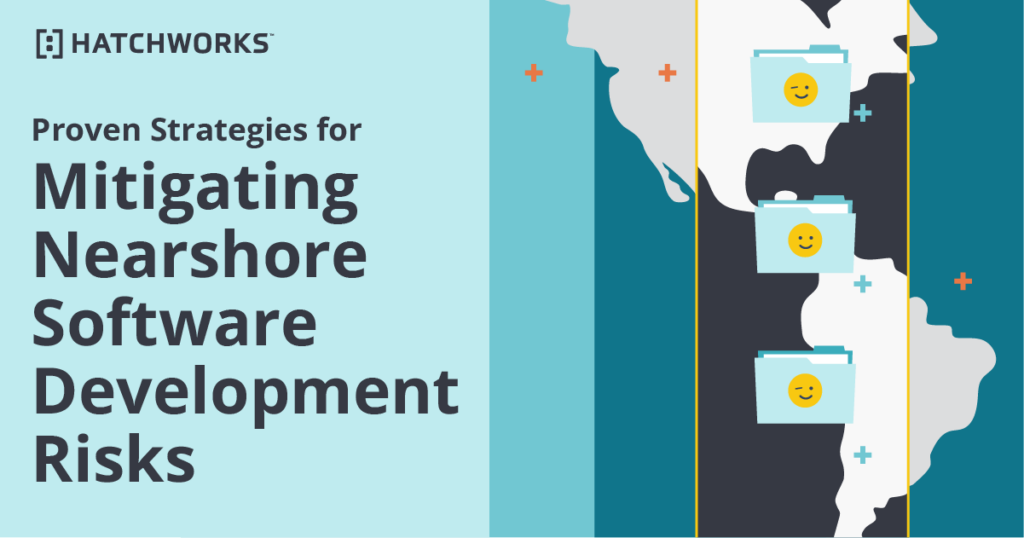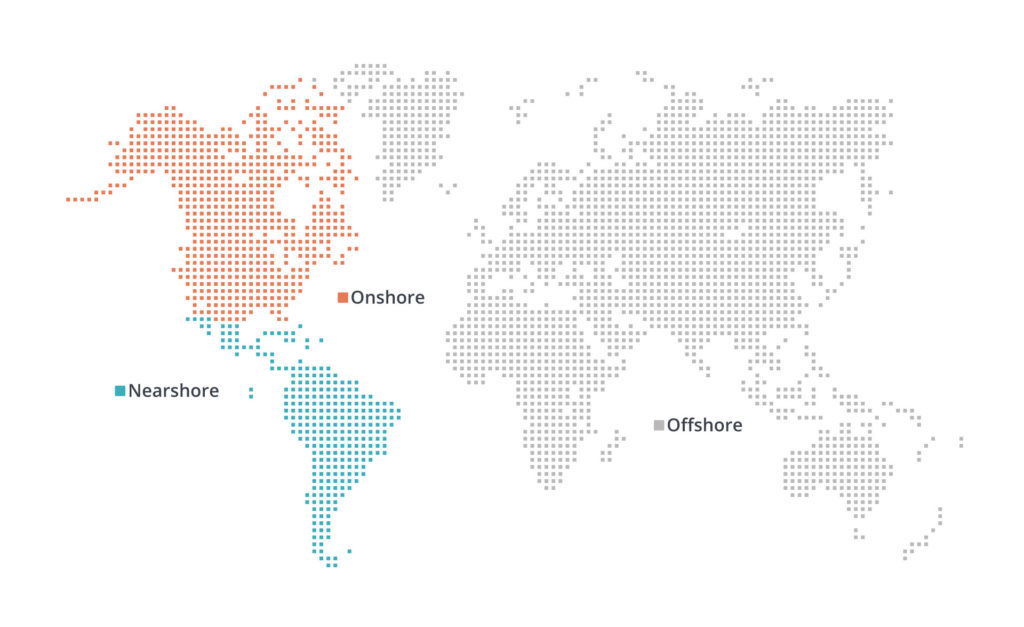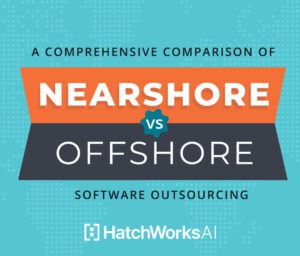You’ve heard of Nearshore Software Development, the outsourcing model that balances cost, convenience, and accessibility. And you think it could be how you build your next software project.
Yet, whispers of potential pitfalls are holding you back: communication breakdowns, cultural clashes, quality inconsistencies… the list goes on.

So now you want to know if you can mitigate these Nearshore Software Development risks and only reap the rewards.
With the right insights, partners, and strategies, you absolutely can.
Read on for our breakdown of the 4 risks you face when using Nearshore Development and 5 practical ways you can avoid them.
But First, What is Nearshore Software Development?
You may know this answer already (and if you do, feel free to scroll on down to the next section) but it’s always helpful to get everyone on the same page.
Nearshore Software Development is when a company outsources development work to a team that works in a country that is geographically close and thus, timezone friendly.
For example, a company based in Atlanta, Georgia that outsources to Costa Rica.
This outsourcing model combines the benefits of Onshore and Offshore software development while avoiding their pitfalls. Translation? It’s both cost-effective and convenient.
Here is a side by side comparison of the three models:
| Nearshore | Offshore | Onshore |
|---|---|---|
|
Outsourcing to neighboring countries with similar time zones.
|
Outsourcing to distant countries with significant time zone differences.
|
Outsourcing within the same country.
|
|
Often cost-effective and allows for easy collaboration.
|
Often cost-effective but can present difficulties in communication.
|
Often costly but avoids cultural differences and language barriers.
|
|
Central and South America
|
Africa, Europe, and Asia
|
United States and Canada
|

3 Reasons Companies Choose Nearshore Software Development
Before we get into the risks and how you can mitigate them, let’s first look at the three core benefits of Nearshore Development.
1. Proximity and Similar Time Zones Facilitate Better Communication and Collaboration
Being geographically close and operating within similar time zones means fewer communication delays.
Teams can collaborate in real-time, ensuring that projects move forward seamlessly and when the odd misunderstanding does happen, they’re promptly addressed.
2. Cost-Effective Alternative to Boutique Agencies
While Onshore development might offer the advantage of cultural and linguistic alignment, it often comes at a premium cost.
Nearshore Development, on the other hand, is a cost-effective alternative. And if you choose a top provider, you won’t sacrifice quality of work or quality of communication.
3. Access to a Diverse and Skilled Talent Pool
Did you know that in 2021 53% of companies struggle to recruit in-house developers? And the reason? The developers didn’t have the skills the business needed.
Nearshore regions often boast a rich pool of tech talent. Companies can tap into this diverse set of skills, ensuring they have the right expertise for their projects without the constraints of local talent shortages.
Take the developers in Latin America that HatchWorks has. We take time to upskill them across 50+ technologies so that no matter the client, we have the exact talent they need.
All of our Nearshore Developers have access to:
- Monthly, employee-led lunch & learns
- Communities of Interest (COIN)
- A Udemy subscription
- $2k year to spend on relevant learning and development
What are the Risks of Using Nearshore Software Development?
As with any business endeavor, you need to know what challenges come with hiring Nearshore Development teams. Because when you know what can go wrong, you can take steps to avoid them—and if needed, overcome them.
Here are the primary risks Nearshore outsourcing might bring:
- Communication and cultural risks
- Quality Risks
- Security Risks
- Geopolitical Risks
Communication, Cultural Differences, and Cultural Risks
Every country has its unique work culture, and these differences can sometimes lead to misunderstandings.
For instance, a developer in Colombia might interpret feedback differently than a project manager in the U.S. due to cultural nuances. Or, there might be instances where holidays and work hours differ, causing unexpected delays.
Quality Risks
Ensuring consistent software quality across borders can be challenging. For example, a Nearshore team might be using a different version of a software tool or might not be familiar with specific coding standards that the in-house team follows.
This can lead to discrepancies in the final product, such as a feature not working as intended or software bugs that were overlooked.
Security Risks
Data breaches and security lapses are concerns regardless of where your development team is located. However, when working with Nearshore teams, there might be instances where they aren’t aware of specific data protection regulations that the company must adhere to.
For instance, a developer might unintentionally store sensitive user data in a less secure environment, exposing it to potential threats.
Geopolitical Risks
The political and economic landscape of a country can have direct implications on your Nearshore Software Development projects.
For example, sudden political unrest or economic downturns in the Nearshore country can disrupt project timelines. Or, changes in trade agreements might impact the cost structure midway through a project.
Proven Strategies to Mitigate Nearshore Software Development Risks
Yes, Nearshore Software Development has its risks. But they’re avoidable with the right approach and a trusted Nearshore partner like HatchWorks.
Below we’ve outlined tried and true strategies to mitigate the risks involved with Nearshore Development.
1. Judge Potential Providers by their Security Protocols and Track Record
Do the Nearshore partners you’re considering have robust data security?
And do they have the testimonials and certifications to prove it?
You’ll want to make sure that’s the case before you get started.
|
✅ Do this
|
🚫 Not that
|
|---|---|
|
Partner with Nearshore providers who invest in their data security and are SOC2 compliant.
|
Sign on with a Nearshore provider who can’t prove or explain how they will keep your data safe.
|
2. Choose a Nearshore Provider with Developers Fluent in English
If you want to avoid language barriers and cultural misunderstandings, the best thing to do is make sure the team you’re working with is fluent in English.
Luckily, many software developers in Latin America speak English to a high standard. And if you want even better odds, this survey from 2021 shows that Argentina has the highest English proficiency score out of the Latin American countries.
You can even take it one step forward by partnering with a provider who has a base in the U.S.
For example, HatchWorks has offices in the U.S. to make sure there’s always cultural alignment and English fluency between you, us, and our team of highly skilled developers.
|
✅ Do this
|
🚫 Not that
|
|---|---|
|
Check that there’s a US team overseeing projects and hiring English speaking developers.
|
Trust blindly that the team can speak English.
|
3. Find an Agile Provider at the Forefront of AI Adoption
Consistent quality development comes off the back of having established frameworks and processes in place. And that point only becomes more important with the introduction of AI.
Statistics show that developers are 55% faster with an AI copilot to help them.
Your Nearshore provider should guide you to AI solutions that align with your business goals and amplify your capabilities.
Most companies don’t know how to leverage AI safely and aren’t following frameworks to determine what is safe adoption and what isn’t. They certainly aren’t able to guide you to effective use of AI.
At HatchWorks we created the Built Right Method which allows us to apply the right frameworks to the projects we’ve taken on and to be at the forefront of AI adoption.
What is the
Built Right Method?
Build software stress-free and on budget with our tried-and-true method that increases speed to value and reduces cost throughout the software development lifecycle.
- Specialized, flexible frameworks
- AI-enhanced development
- Accelerators and automation tech
- Continuous value delivery
- Hyper-enabled, next-gen teams
|
✅ Do this
|
🚫 Not that
|
|---|---|
|
Select a provider like HatchWorks, who not only embraces AI but has a proven framework to leverage it effectively, ensuring your software is built right from the start.
|
Settle for a provider without a clear AI adoption strategy, risking your software's relevance and missing out on the efficiency and innovation AI can bring.
|
4. Establish Clear Communication Channels and Expectations
Before you kick off the project, you need to set clear expectations, define roles, and create a check-in schedule that both you and your Nearshore team will follow.
If your Nearshore team knows who to contact, where, when, and for what, concerns can be addressed promptly, ideation can flow smoothly, and updates communicated effectively.
All of this will streamline project management and collaboration while avoiding the risk of miscommunication or project delays.
This will be made easier if you’re following through on point 3 and have selected an Agile team who can adjust quickly to keep the project on track.
|
✅ Do this
|
🚫 Not that
|
|---|---|
|
Let your Nearshore team know what cadence you expect for updates, the channels they should use to flag problems, and any information they need to meet deadlines.
|
Break your own communication rules, regularly cancel updates and face-to-face meetings, or provide unclear expectations.
|
5. Have a Comprehensive Contract that Provides Legal Clarity
A well-drafted contract acts as a safety net, protecting both parties.
It should clearly outline roles, responsibilities, payment terms, and dispute resolution mechanisms. If you have a legal team, make sure they look over the contract before you sign.
This way your development team can’t surprise you with hidden fees or veer off schedule without good reason.
Another way to ensure reputable and responsible Nearshore Development is to work with a US-based provider who has Errors and Omissions Insurance.
|
✅ Do this
|
🚫 Not that
|
|---|---|
|
Work with legal experts to draft a comprehensive contract that addresses all potential scenarios.
|
Rush into agreements without a detailed contract or overlook key clauses that could protect your interests.
|
6. Use Countries with Low Geopolitical Risks
Choosing a country with a stable political and economic environment is crucial. Factors to consider include political stability, economic growth, and favorable trade relations. You should also choose a provider who has a large geographical footprint spread across LatAm countries.
HatchWorks works with teams from countries with low geopolitical risks so that you never have to worry about interruptions to your project.
And on the off chance that something does happen, we have teams across LatAm that can jump in and pick up where other developers have left off. We also set you up with a team of distributed developers so that you’re never dependent on one country alone.
|
✅ Do this
|
🚫 Not that
|
|---|---|
|
Research and stay updated on the political and economic landscape of the Nearshore country.
|
Ignore geopolitical indicators or assume that the current stability of a country guarantees future stability.
|
Top Time Zone Friendly Destinations for Nearshore Software Development
Now that you’re fully equipped to mitigate risks, where should you turn for Nearshore Development?
Our answer: Latin America. In particular these popular Nearshore locations:
1. Costa Rica: Known for its stable political environment and high education standards, Costa Rica is an emerging player in the nearshore development scene. The country’s emphasis on bilingual education also ensures a workforce fluent in English.
2. Colombia: Medellín and Bogotá are leading the tech revolution in Colombia. The country’s focus on education and tech innovation has produced a generation of skilled developers ready to take on global projects.
3. Brazil: As the largest country in South America, Brazil has a vast tech ecosystem. São Paulo and Rio de Janeiro are at the forefront, with numerous tech companies and startups calling these cities home.
4. Peru: Peru‘s commitment to improving its IT infrastructure and education has fostered a new generation of tech professionals who are agile, skilled, and ready to collaborate on international projects.
5. Mexico: With its proximity to the U.S. and a rapidly growing tech sector, Mexico is a prime location for nearshore development. Cities like Guadalajara and Monterrey are often dubbed the “Silicon Valleys” of Mexico due to their tech-centric ecosystems.
Further reading: Top Latin American Countries for Nearshore Software Development
Avoid the Risks and Reap the Rewards of Nearshore Development with HatchWorks
At HatchWorks we’re dedicated to making your project a success from inception to delivery.
We’re Atlanta based with Nearshore teams across Latin America, giving you onshore quality with offshore affordability.
Our approach is unique and designed to get you the best results.
HatchWorks’ Approach to Nearshore Development
Built from the Ground Up: Unlike many firms that outsource their talent, HatchWorks has meticulously built our Nearshore team from scratch. This dedication is reflected in our 98.5% employee retention rate.
Dedicated Talent: Our Latin America Nearshore teams are 100% committed to your project, ensuring it receives the undivided attention it deserves.
Strategic Positioning: Our teams are strategically located to minimize geopolitical risks, ensuring your projects remain uninterrupted.
US-based support: Every project is set up for success and overseen by a team in the US. They are dedicated and on-hand to make sure your project is delivered on time, on budget, and to the highest standard.
Constant Upskilling: We believe in continuous learning. Our teams are regularly upskilled, bringing expertise across 50+ technologies to your doorstep.
Global Presence: With 8 offices across 6 countries, we have the capability to source rare talent swiftly, ensuring your projects are delivered on time and within budget.
Quick Start: Our streamlined processes and pre-vetted talent pool mean we can kickstart your project in as little as two weeks.
Interested in how HatchWorks can get your project off the ground while cutting your software development costs in half? Contact us today.
Hatchworks: Your US-Based Nearshore Software Development Partner
HatchWorks is a US-based Nearshore software development partner that combines local solutions practice with the affordability and scale of Nearshore outsourcing, all in your time zone.
Start your project in as little as two weeks and cut your software development costs in half.




